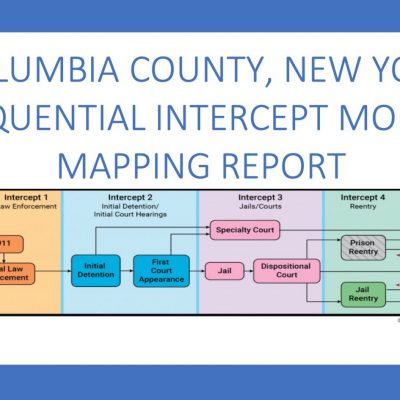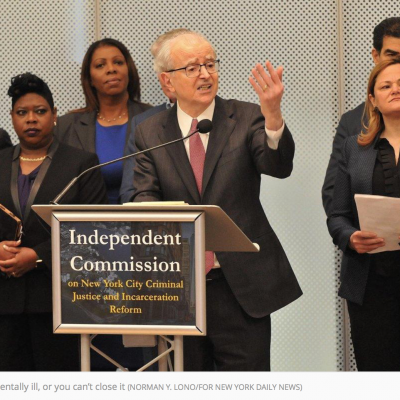Bill’s happy talk on mental illness
By CHERYL ROBERTS
NEW YORK DAILY NEWS
AUGUST 21, 2021
Mayor de Blasio’s recent characterization of Aaron Garcia as having a “mental
health challenge”downplays the realities of the disease and is unfortunately
emblematic of his approach to people living with serious, untreated mental
illness. The next mayor must make a change.
Garcia is of course the man who attacked Miguel Solorzano at an ATM in lower
Manhattan on Sunday, and indications are that he has serious untreated mental
illness.
Someone living with a serious form of cancer does not just have a “physical
health challenge,” any more than a person living with a serious mental illness
has a “mental health challenge.” A person with cancer has a disease which if
untreated, can often result in death. The difference with having an untreated
serious mental illness is not only may you die, but so might someone else.
Solorzano is just lucky he did not turn into that someone else.
If serious mental illnesses are viewed as “challenges” to overcome rather than
diseases to treat, than fixes like providing a hotline number might make some
sense, except of course to victims or loved ones.
According to his family, Garcia, an Iraq War vet, did not return home well.
Someone in the throes of a paranoid delusion cannot or will not call a hotline
number asking for help to quell their paranoia, rid themselves of the conviction
that a loved one works for the CIA, or disprove that devils may live in the coat
closet, making it imperative that the house be burned to the ground.
Severe psychological ailments and substance-use disorders, which often cooccur,
are unique in that in their most serious forms, they can result in the death
of individuals living with the disease, but they can also be the cause of another’s
death. Kendra Webdale, pushed to her death in front of an oncoming subway
train by a person in mental-health crisis, is perhaps the most well-known victim
of this phenomenon.
While the mayor is right that people living with serious mental illness are far
more likely to be the victims of violence when compared to those who do not live
with mental illness, studies from around the world have documented for decades
that people living with certain untreated serious mental illnesses such as
schizophrenia, schizo-effective disorder and bipolar disorder are more violent
than people without a serious mental illness.
In 1992, upon reviewing dozens of studies, law and psychology professor John
Monahan concluded:
“The data that have recently become available, fairly read, suggest the oneconclusion I did not want to reach: Whether the measure is the prevalenceof violence among the disordered or the prevalence of disorder among theviolent, whether the sample is people who are selected for treatment asinmates or patients in institutions or people randomly chosen from theopen community, and no matter how many social and demographic factorsare statistically taken into account, there appears to be a relationshipbetween mental disorder and violent behavior.”
Again, as the Treatment Advocacy Center has noted, “[m]ost acts of violence are
committed by individuals who are not mentally ill” and when people with
serious mental illnesses receive appropriate treatment and medications, there
is no evidence to suggest that “they are any more dangerous than individuals in
the general population.” Still, a 2009 meta-analysis of 204 studies of psychosis
as a risk factor for violence confirmed the earlier finding of Monahan:
“compared with individuals with no mental disorders, people with psychosis
seem to be at a substantially elevated risk for violence.” Psychosis “was
significantly associated with a 49%-68% increase in the odds of violence.”
These studies also found that certain factors contribute to the higher incidence
of violence among this population, including medication noncompliance, a lack
of awareness of mental illness (anosognosia), use of alcohol and or drugs, and
homelessness.
It is still unclear whether Garcia was subject to Kendra’s Law, though it sounds
like he should have been. Kendra’s Law allows judges to place those with serious
mental illness into mandated and monitored treatment for up to one year if they
have a history of multiple arrests, hospitalizations and an inability to comply
with treatment. It is designed to provide exactly those supports which could
lower the incidence of violence. For Garcia, this was not his first run-in with
police. During the past year, he was the subject of five previous emotionally
disturbed person callsand has also been arrested eight times for stalking,
harassment and violating an order of protection. At the time of the attack on
Solorzano, there was an active warrant for his arrest. He was also known in the
community as having unpredictable and threatening behavior. Yet somehow, he
was missed.
The next administration must make the treatment of those living with serious
mental illness a priority, not an afterthought. It is more than a “challenge,” it is
an imperative.
Roberts is executive director of the Greenburger Center.



































